
Ascomycota is a phylum of the kingdom Fungi that, together with the Basidiomycota, forms the subkingdom Dikarya. Its members are commonly known as the sac fungi or ascomycetes. It is the largest phylum of Fungi, with over 64,000 species. The defining feature of this fungal group is the "ascus", a microscopic sexual structure in which nonmotile spores, called ascospores, are formed. However, some species of the Ascomycota are asexual, meaning that they do not have a sexual cycle and thus do not form asci or ascospores. Familiar examples of sac fungi include morels, truffles, brewers' and bakers' yeast, dead man's fingers, and cup fungi. The fungal symbionts in the majority of lichens such as Cladonia belong to the Ascomycota.

In biology, a spore is a unit of sexual or asexual reproduction that may be adapted for dispersal and for survival, often for extended periods of time, in unfavourable conditions. Spores form part of the life cycles of many plants, algae, fungi and protozoa.

An ascus is the sexual spore-bearing cell produced in ascomycete fungi. Each ascus usually contains eight ascospores, produced by meiosis followed, in most species, by a mitotic cell division. However, asci in some genera or species can occur in numbers of one, two, four, or multiples of four. In a few cases, the ascospores can bud off conidia that may fill the asci with hundreds of conidia, or the ascospores may fragment, e.g. some Cordyceps, also filling the asci with smaller cells. Ascospores are nonmotile, usually single celled, but not infrequently may be coenocytic, and in some cases coenocytic in multiple planes. Mitotic divisions within the developing spores populate each resulting cell in septate ascospores with nuclei. The term ocular chamber, or oculus, refers to the epiplasm that is surrounded by the "bourrelet".

Neurospora crassa is a type of red bread mold of the phylum Ascomycota. The genus name, meaning "nerve spore" in Greek, refers to the characteristic striations on the spores. The first published account of this fungus was from an infestation of French bakeries in 1843.
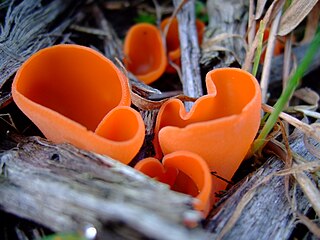
Pezizomycotina make up most of the Ascomycota fungi and include most lichenized fungi too. Pezizomycotina contains the filamentous ascomycetes and is a subdivision of the Ascomycota. It is more or less synonymous with the older taxon Euascomycota. These fungi reproduce by fission rather than budding and this subdivision includes almost all the ascus fungi that have fruiting bodies visible to the naked eye.
Heterothallic species have sexes that reside in different individuals. The term is applied particularly to distinguish heterothallic fungi, which require two compatible partners to produce sexual spores, from homothallic ones, which are capable of sexual reproduction from a single organism.
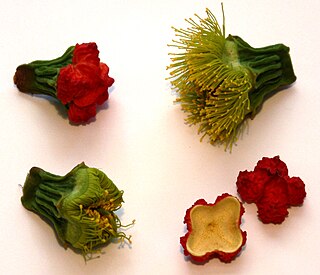
In botany, an operculum (pl. opercula) or calyptra is a cap-like structure in some flowering plants, mosses, and fungi. It is a covering, hood or lid, describing a feature in plant morphology.

Mating in fungi is a complex process governed by mating types. Research on fungal mating has focused on several model species with different behaviour. Not all fungi reproduce sexually and many that do are isogamous; thus, for many members of the fungal kingdom, the terms "male" and "female" do not apply. Homothallic species are able to mate with themselves, while in heterothallic species only isolates of opposite mating types can mate.
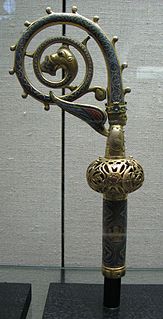
A crozier is an anatomical feature of many fungi in the phylum Ascomycota that forms at the base of asci and looks like a hook-topped shepherd’s staff or stylized religious crosier. Croziers resemble and function similarly to clamp connections on the dikaryotic hyphae of Basidiomycota.

Dikarya is a subkingdom of Fungi that includes the divisions Ascomycota and Basidiomycota, both of which in general produce dikaryons, may be filamentous or unicellular, but are always without flagella. The Dikarya are most of the so-called "higher fungi", but also include many anamorphic species that would have been classified as molds in historical literature. Phylogenetically the two divisions regularly group together. In a 1998 publication, Thomas Cavalier-Smith referred to this group as the Neomycota.
In mycology a tissue or feature is said to be amyloid if it has a positive amyloid reaction when subjected to a crude chemical test using iodine as an ingredient of either Melzer's reagent or Lugol's solution, producing a blue to blue-black staining. The term "amyloid" is derived from the Latin amyloideus ("starch-like"). It refers to the fact that starch gives a similar reaction, also called an amyloid reaction. The test can be on microscopic features, such as spore walls or hyphal walls, or the apical apparatus or entire ascus wall of an ascus, or be a macroscopic reaction on tissue where a drop of the reagent is applied. Negative reactions, called inamyloid or nonamyloid, are for structures that remain pale yellow-brown or clear. A reaction producing a deep reddish to reddish-brown staining is either termed a dextrinoid reaction or a hemiamyloid reaction.
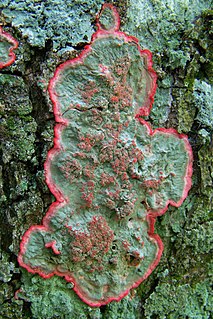
The Arthoniales is the second largest order of mainly crustose lichens, but fruticose lichens are present as well. The order contains around 1500 species, while the largest order with lichenized fungi, the Lecanorales, contains more than 14000 species.

The Arthoniaceae are a family of lichenized, lichenicolous and saprobic fungi in the order Arthoniales. The Arthoniaceae is the largest family of Arthoniales, with around 800 species. Most species in Arthoniaceae belong in Arthonia which is the largest genus with 500 species. The second and third largest genus is Arthothelium with 80 species, and Cryptothecia with 60 species.

Wynnea americana, commonly known as moose antlers or rabbit ears, is a species of fungus in the family Sarcoscyphaceae. This uncommon inedible species is recognizable by its spoon-shaped or rabbit-ear shaped fruit bodies that may reach up to 13 cm (5.1 in) tall. It has dark brown and warty outer surfaces, while the fertile spore-bearing inner surface is orange to pinkish to reddish brown. The fruit bodies grow clustered together from large underground masses of compacted mycelia known as sclerotia. In eastern North America, where it is typically found growing in the soil underneath hardwood trees, it is found from New York to Michigan south to Mexico. The species has also been collected from Costa Rica, India, and Japan.
Polytolypa is a monotypic genus of fungus containing the single species Polytolypa hystricis. First classified in the Onygenaceae family, as of 2008 it is considered to be in the Ajellomycetaceae, although there is still uncertainty as to its phylogenetic relationships with other similar genera. This species is only known from a single specimen derived in the laboratory from a specimen of dung of the North American porcupine, Erethizon dorsatum, collected in Ontario, Canada. Polytolypa hystricis contains bioactive compounds that have antifungal activity.
The Aliquandostipitaceae are a family of fungi in the Ascomycota, class Dothideomycetes. The family was described by Patrik Inderbitzin in 2001, and the order Jahnulales was created in 2002 to accommodate the family. The distinguishing characteristic for members of the family are the unusually wide hyphae that support the spore-bearing structures, and the presence of ascomata both with and without stalks. The genus Aliquandostipe has a pantropical distribution, having been found in Central America and southeast Asia; Jahnula has a wider distribution. Species in the family are saprobic, and are typically found growing on rotting wood.
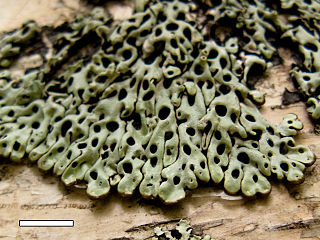
Menegazzia is a genus of lichenized fungi containing roughly 70 accepted species. The group is sometimes referred to as the tree flutes, honeycombed lichens, or hole-punch lichens. The most obvious morphological feature of the genus is the distinctive perforations spread across the upper side of the thallus. This makes the group easy to recognise, even for those not particularly familiar with lichen identification.

Anzia is a genus of foliose lichens known as black-foam lichens in the large family Parmeliaceae. It was formerly included in the monogeneric family Anziaceae, but this has since been subsumed into the Parmeliaceae.

Kalapuya brunnea is a species of truffle in the monotypic fungal genus Kalapuya. The truffle occurs only in the Pacific Northwest region of the United States, in western Oregon and northern California. Known locally as the Oregon brown truffle, it was formerly thought to be an undescribed species of Leucangium until molecular analysis demonstrated that it was distinct from that genus. The truffle is reddish brown with a rough and warty outer skin, while the interior spore-producing gleba is initially whitish before developing greyish-brown mottling as it matures. Mature truffles have an odor resembling garlicky cheese, similar to mature Camembert. The species has been harvested for culinary purposes in Oregon.
Cruentotrema is a genus of corticolous (bark-dwelling) lichens in the family Graphidaceae. It has seven species.
















